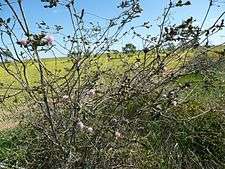Melaleuca orbicularis
Melaleuca orbicularis is a plant in the myrtle family, Myrtaceae and is endemic to the south-west of Western Australia. It is similar to Melaleuca cordata with its pinkish "pom-pom" heads of flowers but its leaves are smaller, almost circular compared to the heart shaped leaves of the other species.
| Melaleuca orbicularis | |
|---|---|
 | |
| Melaleuca orbicularis foliage, flowers and fruit | |
| Scientific classification | |
| Kingdom: | Plantae |
| Clade: | Tracheophytes |
| Clade: | Angiosperms |
| Clade: | Eudicots |
| Clade: | Rosids |
| Order: | Myrtales |
| Family: | Myrtaceae |
| Genus: | Melaleuca |
| Species: | M. orbicularis |
| Binomial name | |
| Melaleuca orbicularis | |
Description
Melaleuca orbicularis is an erect shrub growing to 2.5 m (8 ft) tall. Its leaves are arranged alternately and are 3.5–8 mm (0.1–0.3 in) long, 2–10.5 mm (0.08–0.4 in) wide, heart-shaped to almost circular.[1][2]
The flowers are a shade of pink to purple and are arranged in heads on the ends of branches which continue to grow after flowering and sometimes also in the upper leaf axils. The heads are up to 30 mm (1 in) in diameter with 2 to 8 groups of flowers in threes. The petals are 2–3 mm (0.08–0.1 in) long and fall off soon after the flower opens. The outer surface of the floral cup (the hypanthium) is hairy and there are five bundles of stamens around the flower, each with 5 to 12 stamens. Flowering occurs from July to January and is followed by fruit which are woody capsules, 3–5 mm (0.1–0.2 in) long, usually in tight, oval-shaped clusters along the stem.[1][2]


Taxonomy and naming
Melaleuca orbicularis was first formally described in 1999 by Lyndley Craven in Australian Systematic Botany from a specimen collected near Bindi Bindi.[3][4] The specific epithet (orbicularis) is a Latin word meaning "circular"[5] referring to the circular leaves.[1]
Distribution and habitat
Melaleuca orbicularis occurs in and between the Coorong, Wongan Hills and Cowcowing districts[1] in the Avon Wheatbelt, Geraldton Sandplains, Jarrah Forest and Warren biogeographic regions.[6] It grows in a range of vegetation associations in sand over sandstone and laterite.[1][7]
Conservation
Melaleuca orbicularis is listed as "not threatened" by the Government of Western Australia Department of Parks and Wildlife.[6]
References
- Brophy, Joseph J.; Craven, Lyndley A.; Doran, John C. (2013). Melaleucas : their botany, essential oils and uses. Canberra: Australian Centre for International Agricultural Research. p. 257. ISBN 9781922137517.
- Holliday, Ivan (2004). Melaleucas : a field and garden guide (2nd ed.). Frenchs Forest, N.S.W.: Reed New Holland Publishers. pp. 66–67. ISBN 1876334983.
- "Melaleuca orbicularis". APNI. Retrieved 5 June 2015.
- Craven, L. A.; Lepschi, B. J. (1999). "Enumeration of the species and infraspecific taxa of Melaleuca (Myrtaceae) occurring in Australia and Tasmania". Australian Systematic Botany. 12 (6): 893. doi:10.1071/SB98019.
- Brown, Roland Wilbur (1956). The Composition of Scientific Words. Washington, D.C.: Smithsonian Institution Press. p. 205.
- "Melaleuca orbicularis". FloraBase. Western Australian Government Department of Parks and Wildlife.
- Paczkowska, Grazyna; Chapman, Alex R. (2000). The Western Australian flora : a descriptive catalogue. Perth: Wildflower Society of Western Australia. p. 396. ISBN 0646402439.